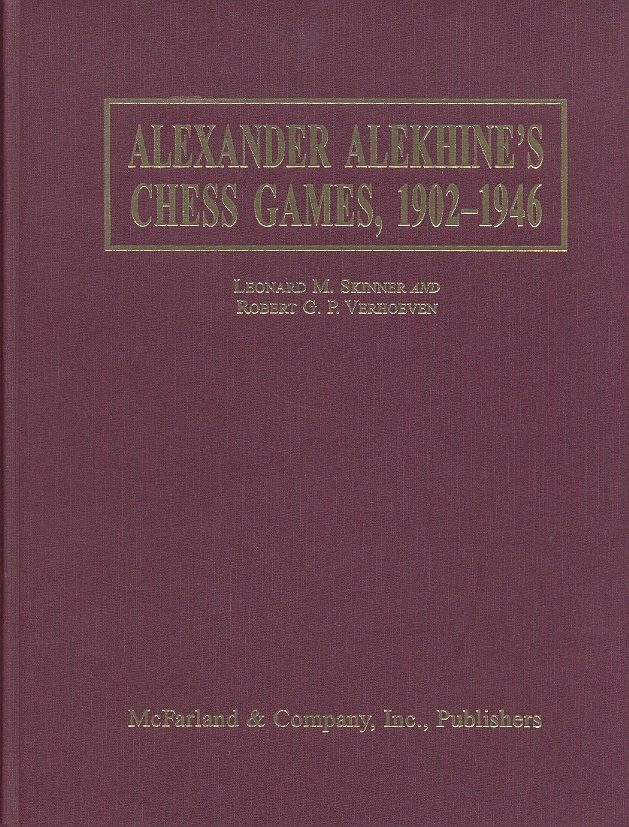
Edward Winter

Alexander Alekhine’s Chess Games, 1902-1946 by Leonard M. Skinner and Robert G.P. Verhoeven (McFarland & Company, Inc., Jefferson, 1998).
Alekhine ‘certainly seems to have his eye on the top rung of the ladder’, wrote the November 1912 American Chess Bulletin (page 245). Despite that, l’homme pressé had to wait 15 years (a period including the Great War, the Russian Revolution and, even, some erroneous death-notices) before becoming world champion. As he neared his goal of a match against Capablanca, his playing-record remained patchier than is sometimes imagined, particularly in tournaments which also featured other potential challengers. When he defeated the Cuban in Buenos Aires he was 35 years old, Kasparov’s age today, yet he went on to scale further heights at San Remo, 1930 and Bled, 1931. The decline which eventually and inescapably set in was by no means as abrupt as has been suggested, and even in the 1940s he was still playing many wonderful games and writing as lucidly as ever.
No serious chess authority has doubted that Alekhine was among the very greatest masters of all time, but he is one of those players (Steinitz is another) whom many writers feel at particular liberty to maul in the grubbiest personal terms. Reuben Fine’s psychology book called Alekhine ‘the sadist of the chess world’. Raymond Keene, not content with co-authoring a gaffe-packed book which dumped Alekhine as number 18 on the list of all-time best players, claimed in Chess An Illustrated History that Alekhine played the 1935 world championship match ‘more or less in a perpetual stupor’. Harold C. Schonberg’s Grandmasters of Chess called Alekhine ‘as amoral as Richard Wagner or Jack the Ripper’.
There is none of that sort of thing in Alexander Alekhine’s Chess Games, 1902-1946. The Foreword, by the master’s son, Alex A. Aljechin, rightly protests: ‘Normal standards of journalistic decency are often ignored. My father does not deserve to be treated in this way.’ It must puzzle him why Alekhine’s personal flaws, actual or fictitious, sometimes stimulate more interest than do his games and writings, but throughout this excellent new book the play is the thing. Where such painful issues as the Nazi articles affair are mentioned – as one way or another they must be – the account is coolly restrained.
Not that the volume slides into hagiography. On a number of occasions various ‘unpleasant incidents’ are recorded, petty behaviour ascribable to Alekhine’s undoubtedly short fuse. Even so, each such episode (and significantly they tended to occur in simultaneous exhibitions rather than ‘serious’ events) can be matched by a contemporaneous report of the rank and file’s appreciation of the visiting master’s cordiality, solicitude and charm.
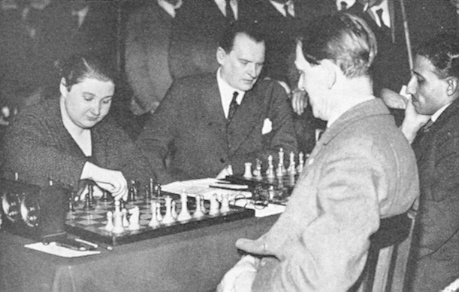
London, 1932. From left to right: Vera Menchik, Alexander Alekhine, Géza Maróczy and Sultan Khan
Alex A. Aljechin also comments that his father’s ‘definitive chess biography has yet to be published’. Although each chapter of the book under review contains a biographical account by way of introduction to the games and event reports, what is principally on offer is extraordinarily deep delving into Alekhine’s over-the-board exploits. That requires a huge 807-page book, beautifully hardbound, with, in all, 2,543 games (including some fragments). The ground covered is well demonstrated by the concluding reference and index material. Pages 736-764 give crosstables ranging from a 1902-03 correspondence tournament to Cáceres, 1945. There follows a detailed 22-page results list of Alekhine’s matches, tournaments and exhibitions. After seven pages of bibliography comes an index of his opponents and consultation partners, a full 27 columns occupying nine pages. Finally, we are provided with the openings indices, stretching from A00 to E90. There are even early games in which Alekhine played Alapin’s Opening (1 e4 e5 2 Ne2), although he was later to refer to ‘this grotesque knight move’ (page 29). Readers who like to see varied openings will not be disappointed, given Alekhine’s propensity for playing lines which world champions usually avoid. An example is the Döry Defence (1 d4 Nf6 2 c4 e6 3 Nf3 Ne4), which he essayed in a 1938 tournament game. There are over two hundred French Defence games, and the database buccaneers will not be slow to plunder the book’s treasures.
The figure of 2,543 games is to be compared with the 1,577 boasted by The Games of Alekhine by Rogelio Caparrós and Peter Lahde (published in 1992). Unlike their feeble predecessors, Messrs Skinner and Verhoeven have presented the scores with exact dates and sources. Moreover, many of the games have Alekhine’s own annotations from lesser-known publications. Our shelves contain well over a hundred books by and about Alekhine. The ‘about’ category includes many cheap-jack contractions of Alekhine’s own works, with the master’s annotations shamelessly appropriated with little or no credit given. This new book has adopted the opposite approach, leaving to one side Alekhine’s best-known annotations on the legitimate assumption that the reader will not need them again. Countless fresh insights into Alekhine’s thinking are thus on offer. To quote a snippet at random: ‘One should not, or must not, develop the bishops in fianchetto without having previously dominated at least one of the central squares. If this is not done, one’s opponent gets sufficient freedom of action that is enough to transform it into a superiority that is almost conclusive’ – La Nación, 4 May 1930 (taken from page 205). On the other hand, a criticism may be made: Alekhine wrote up so many of his own games that some of his annotations have unjustifiably been omitted.
The chronicle begins with an exceptionally well-investigated record of Alekhine’s early years and a large number of unpublished games from his notebooks. He became such an active player, tireless globetrotter and prolific annotator that in-depth researching of his career must have been an uncommonly gruelling task. Wherever he travelled, the co-authors have endeavoured to follow up on his exploits through reports in magazines and newspaper columns. His 1933 visit to the Far East, for instance, is chronicled on the basis of such sources as The China Press (Shanghai), the South China Morning Post, the China Mail and the Hong Kong Daily Press. About 75 games from that tour are provided, together with detailed local reports. It is pointed out that one of his opponents at a display in Tokyo, Grace Freeman, later married him.
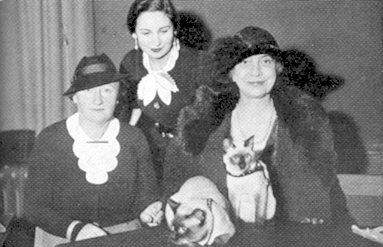
From left to right, the wives of Hans Kmoch, Salo Flohr and Alexander Alekhine
For those already familiar with most of Alekhine’s ‘best’ games, a major attraction will be the hundreds of simultaneous games, which may be regarded as the chess artist’s pencil sketches. Although Alekhine wrote (see page 213) that they were rarely ‘a perfect model of correctness’, the entertainment and instructional value of encounters between master and amateur is often extremely high. His blindfold exploits in particular were awesome and, it would seem, are beyond the capacity of anybody alive today. Not unexpectedly, Alekhine’s losses are over-represented in the book, because of the tendency of parochial columnists to publish the club hero’s isolated or fluke defeat of the maestro. Over the years, how many chess masterpieces have been lost through journalistic provincialism?
In a work of this size (it will doubtless be the largest chess book that some enthusiasts will ever own) there are inevitably some misprints and other defects. It has to be said that typographical errors are more frequent than would be expected, that a few of the translated annotations bear only a passing resemblance to English and that it is rare to find, even in the chess world, such a poorly punctuated book. Of more substantial importance is the editorial decision to give notes by Alekhine alone. This means, for example, that Game 1708 – against Hulscher (an opponent whom Alekhine misnamed ‘Mindeno’ in his second Best Games volume) – is mute concerning the subsequent analytical controversy about Alekhine’s concluding combination. It is a particular pity that the annotational finds of John Nunn in the (truncated but useful) Alexander Alekhine’s Best Games (Batsford, 1996) have been ignored. The co-authors have even passed up the opportunity to set the record straight on some historical matters. On page 235 Alekhine wrote that after 1 d4 Nf6 2 c4 e6 3 Nc3 d5 4 Bg5 c6 5 e3 he was unaware of 5…Qa5 having been played in master praxis. It had occurred (with a transposition of moves) in Pillsbury v Janowsky, Budapest, 1896 and Reggio v Pillsbury, Monte Carlo, 1903. Similarly, on page 509 we read, after 1 e4 e5 2 Nf3 Nc6 3 Bb5 a6 4 Ba4 d6 5 O-O Nf6, a claim by Alekhine to have introduced 6 c3, a move already seen in Walbrodt v Steinitz, Hastings, 1895.
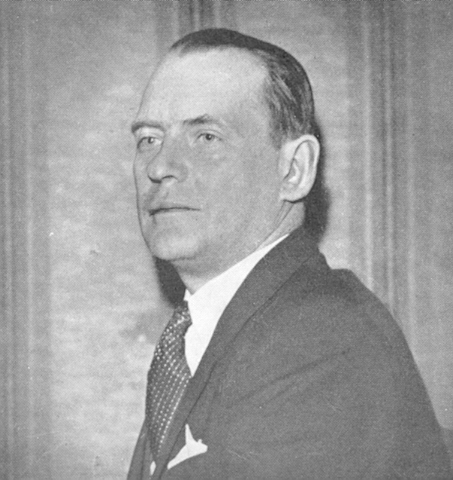
Alexander Alekhine in the 1930s
Yet such blemishes (of conception or of detail) are dwarfed by what has been achieved: outstanding detective work which will transform readers’ knowledge of Alekhine. All those verbalisms which are dragged out by reviewers to describe the most humdrum and inaccurate of chess books (‘not to be missed’, ‘deserving a place in every chess lover’s library’, etc.) should have been saved for this one. Some reviews try to prod people into buying a new book on the grounds that the chess world should support the publisher, almost as if it were a charity. Regardless of the gratitude that we owe to McFarland & Company, Inc., no such special pleading is necessary here. Alexander Alekhine’s Chess Games, 1902-1946 should be bought on its merits by anyone who cares about chess and its finest exponents. It is a superb piece of work which immediately takes its place in that highest and rarest class of books: those which permanently enrich our beloved game.
Afterword: The above article, first published on pages 75-78 of the 4/1998 New in Chess, remains our most recent book review.
A strange position allegedly from a game between Alekhine and Bogoljubow (‘Vienna, 1922’) has been published in a number of places (e.g. on page 180 of the Skinner/Verhoeven book on Alekhine). At the Chess History Center website conducted by Richard Forster it has now been revealed, following research by Jack O’Keefe, that it was all a joke/hoax by J. Krejcik, who gave the position on pages 39-40 of his book 13 Kinder Caïssens (Vienna, 1924).
(2463)
On 8 March 2022 Richard Forster (Winterthur, Switzerland) reported to us that Leonard Skinner had died at home in Llandow, Wales on 7 March 2022. His family has also provided the information that Leonard Skinner was born in Cardiff on 29 October 1928.
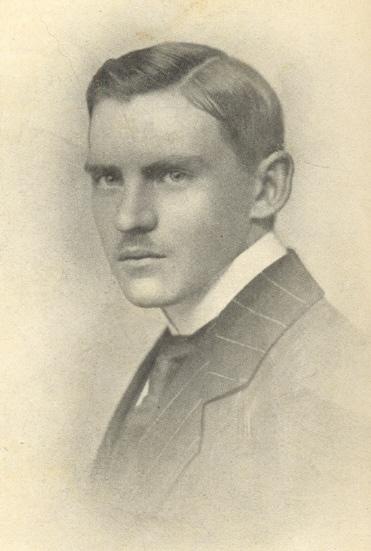
Below is our assessment (first published in the Autumn 1996 issue of Kingpin) of Alexander Alekhine’s Best Games by Alexander Alekhine with additional material by C.H.O’D. Alexander and John Nunn (London, 1996):
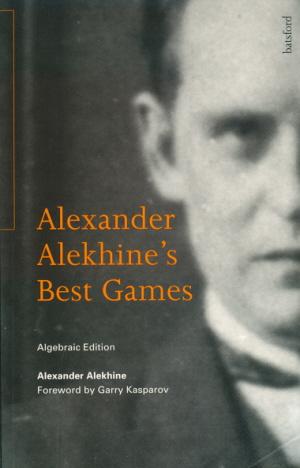
English-language chess publishers’ sluggishness in providing algebraic editions of classic books is such that even the much-loved Alekhine trilogy, which contains some 260 games, is still available only in the descriptive notation. Alexander Alekhine’s Best Games, a severely abbreviated selection of what the publishers janglingly call ‘algebraicised games’, is no adequate substitute.
Well over half of the trilogy’s games have simply vanished, the editorial shears having been wielded at the particular expense of tournament encounters against lesser-lights and brilliancies from simultaneous displays. The book jumps from 1914 to 1919 without an annotated game; after AVRO, 1938, Alekhine was an active world champion for more than seven years, but we are left with only five of his games from that period (all against Keres and Junge, and all played in 1942).
The sole good news, though certainly it is substantial, is that John Nunn, who typeset the abridgement, has added dozens of footnotes, mostly to contradict the assessments of Alekhine and Alexander. To quote a simple case (a note to Black’s 18th move in Alekhine v Isakov, Moscow, 1919), page 33 points out 20 Rxe6+, a move missed by Alekhine himself and a number of annotational parrots. Page after page demonstrates Dr Nunn’s sedulous insights, which may actually outnumber those presented in all previous sources since the day Alekhine first set pen to paper.
How unfortunate, therefore, that the book is also marred by Batsford’s abiding indifference to the historical record. Eye-catching errors have been left uncorrected from Alekhine’s time. (Examples: Mährisch-Ostrau, 1924 instead of 1923 on page 27; a curious cross-reference to the wrong Selesniev game on page 83; an untrue remark on page 100 that 1 g3 e5 2 Nf3 was ‘an experiment which Réti never repeated after the present game’; Kemeri, 1927, rather than 1937, on page 282.) Moreover, fresh mistakes have been added. (For instance: on page 227 a mysterious misspelling ‘Aretsson’, instead of Axelsson as correctly given by Alekhine; Munich, 1943, rather than 1942, on page 300; in the index of opponents, the suggestion of three games against the same Steiner.)
Insufficient knowledge of Alekhine lore is much in evidence. Page 37 gives without comment a 15-move game against Tenner which is well known to be spurious. Nor is there any amendment of Alekhine’s curtailed versions of his games against Sterk (page 49) and Rubinstein (page 114). Many analytical emendations pointed out over the years by third parties are ignored; for instance, Alekhine’s note to Black’s 20th move in his game against Kimura at Tokyo, 1933 has been widely censured, but the Batsford book offers no comment. Concerning the brilliancy against Böök at Margate, 1938, there is even apparent unawareness of the (readily available) annotations of Alekhine himself.
It must be hoped that this book’s new analysis will not be similarly disregarded when a future publisher ventures to produce what is really needed: a conscientiously edited algebraic edition of Alekhine’s complete original choice of best games.
Regarding the above-mentioned Alekhine v Tenner game, page 54 of the Skinner/Verhoeven book (which was, of course, published after Alexander Alekhine’s Best Games) reported that The Unknown Alekhine by Fred Reinfeld (New York and London, 1949) referred to a conversation between Reinfeld and Tenner in 1948. The McFarland book did not mention that Reinfeld had also quoted Tenner’s much earlier denial that the game-score was correct (in the Brooklyn Daily Eagle in 1927, the year when Alekhine’s first Best Games volume was published). See pages 93-95 of Reinfeld’s book.
Below is the full chess column by Hermann Helms on page 4A of the 29 December 1927 edition of the Brooklyn Daily Eagle:

To the Chess Notes main page.
To the Archives for other feature articles.
Copyright: Edward Winter. All rights reserved.